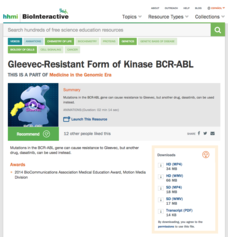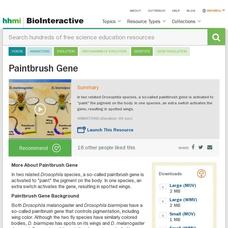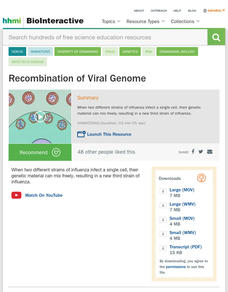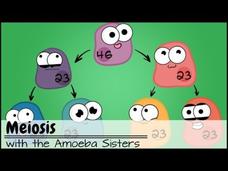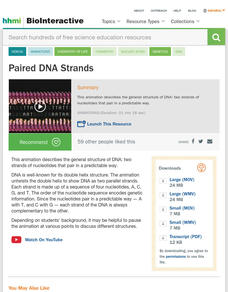FuseSchool
What Are Stem Cells?
Almost every cell in the body has a special job. Part of the Fuse School Genetics playlist, the video discusses the few unspecialized cells, called stem cells. It explains where they are found, what they do, and why they raise ethical...
FuseSchool
What Is Asexual Reproduction?
Nature clones plants and animals through asexual reproduction. The video explains what asexual reproduction is and the process involved. It highlights some of the plants, bacteria, and animals that use asexual reproduction. The video...
Howard Hughes Medical Institute
RNA Folding
Don't leave genetics to the imagination! Demonstrate to your class the folding of RNA using a video animation. The animation shows the structure of RNA and how it folds on itself to create protein-like structures.
Amoeba Sisters
Pedigrees
Pupils puzzled by pedigree charts? Not anymore! Show them proper pedigree protocol using a short video from an excellent biology playlist. Content includes pedigree symbols and terminology, interpreting pedigrees of various lengths, and...
Howard Hughes Medical Institute
Pocket Mouse Evolution
G.H. Hardy and Wilhelm Weinberg created a mathematical formula to predict genotype frequencies. Observe a simulation of the Hardy-Weinberg equation using pocket mice. Scholars consider the selection coefficient, selective advantage, and...
Howard Hughes Medical Institute
Damage to DNA Leads to Mutation
While our bodies have incredible capabilities to repair damage, some mutations accumulate and lead to disease. Follow the life of a DNA mutation using a computer-generated animation. The narrator explains the impact of radiation,...
Teacher's Pet
Mutations in DNA
A human genome accumulates approximately 64 mutations per generation. The video explains the four types of mutations in DNA and their importance—or lack of importance. It incorporates knowledge about protein synthesis and combines it...
Howard Hughes Medical Institute
Gleevec-Resistant Form of Kinase BCR-ABL
Gene mutation occurs at a rate much higher than many realize. Doctors treating cancer and other illnesses must learn to adapt quickly after each mutation. Viewers observe an animation and watch lecture with props to see what happens when...
TED-Ed
How to Biohack Your Cells to Fight Cancer
Is it possible to use biotechnology to trick your body into fixing cancer-causing mutations? A video presentation discusses both traditional and new technologies that fight cancer. The amazing technologies are sure to intrigue viewers as...
Howard Hughes Medical Institute
mRNA Splicing
Edit, copy, and paste are not just for word processing! Learn how a gene transcribes into mRNA and then translates into a protein. Editing is the first step and is the focus of the animation as it demonstrates how special enzymes remove...
Amoeba Sisters
Gel Electrophoresis
Ever wonder how scientists determine how animals are related, or who is guilty of a crime? Discover gel electrophoresis in an easy-to-understand video from a fun biology playlist. Topics include how restriction enzymes create segments of...
Howard Hughes Medical Institute
Paintbrush Gene
Drosophila includes more than 1,500 species and often find themselves studied by geneticists. A scientist presents a lecture on one example of these studies on the paintbrush gene. The gene determines the amount and color of pigment on...
Be Smart
Why Do Disney Princesses All Look like Babies?
Could Disney be tricking people into caring about their characters? It seems the design of characters in recent years triggers our nurturing instincts. A video explains the science behind these instinctual habits—and why viewers are so...
Howard Hughes Medical Institute
Translation (Basic Detail)
RNA translates three letters at a time to create a perfect protein chain. With the help of an animation, viewers discover the process of translation in real time. From ribosome to protein, the program creating living things finds...
Be Smart
Why Do You Love Your Family?
Is that warm, fuzzy family feeling a product of evolution? Explore altruism through a video from an engaging science series. The narrator discusses parental instincts, evolutionary fitness, and an organism's drive to ensure it passes its...
Howard Hughes Medical Institute
Recombination of Viral Genome
More than 144 sub-types of influenza A exist today. How is that possible? Scholars view an animation of a cell being attacked by two different strains of the flu. Then the strains mix, creating an entirely new third strain. The idea of...
Amoeba Sisters
Meiosis
Why do siblings often look so different from one another? Discover the process of making gametes using a short video from a large biology playlist. The narrator explains each step while animated chromatids play out the scenario that...
Howard Hughes Medical Institute
Somatic Cell Nuclear Transfer Animation
One cloning technique is somatic cell nuclear transfer (SCNT). Observe the process in action through an animated video. Review the applications of the process for both therapeutic cloning and cloning of an individual.
Howard Hughes Medical Institute
Lactose Digestion in Infants
Milk meets every single nutritional need for a baby in the first six months of life. Observe how an infant's small intestine breaks milk lactose down into a usable form of nutrition. With the help of an animation, viewers see the process...
Howard Hughes Medical Institute
Paired DNA Strands
What happens when you untwist and unzip DNA? View the fascinating process and learn about the pieces that make up DNA in an informative video. It highlights the base pairing and sequencing rules within each strand.
Crash Course
Animal Behavior
While a herd of cows are eating, they tend to all face the same direction. Viewers explore the world of animal behavior, looking at both morphology and physiology, with a video that focuses on the evolutionary history of learned...
Curated OER
Sex-Linked Traits
Again, the basis for trait inheritance and the impact of alleles in phenotypes was covered in previous videos. This presentation focuses on gender and the likelihood of traits if they are sex-linked. Sal tells a great anecdote about...
Curated OER
Phases of Mitosis
The lecturer starts by emphasizing that the mitotic process is a separate mechanism to cytokinesis - the cytoplasm splitting to become 2 cells. The video continues explaining the stages of mitosis in great detail. Each stage is...
Crash Course
Photosynthesis
Seventy percent of the world's oxygen is produced through photosynthesis by phytoplankton, microscopic plants found in the ocean. Viewers learn about the complex process of photosynthesis with a video that covers both the light dependent...









